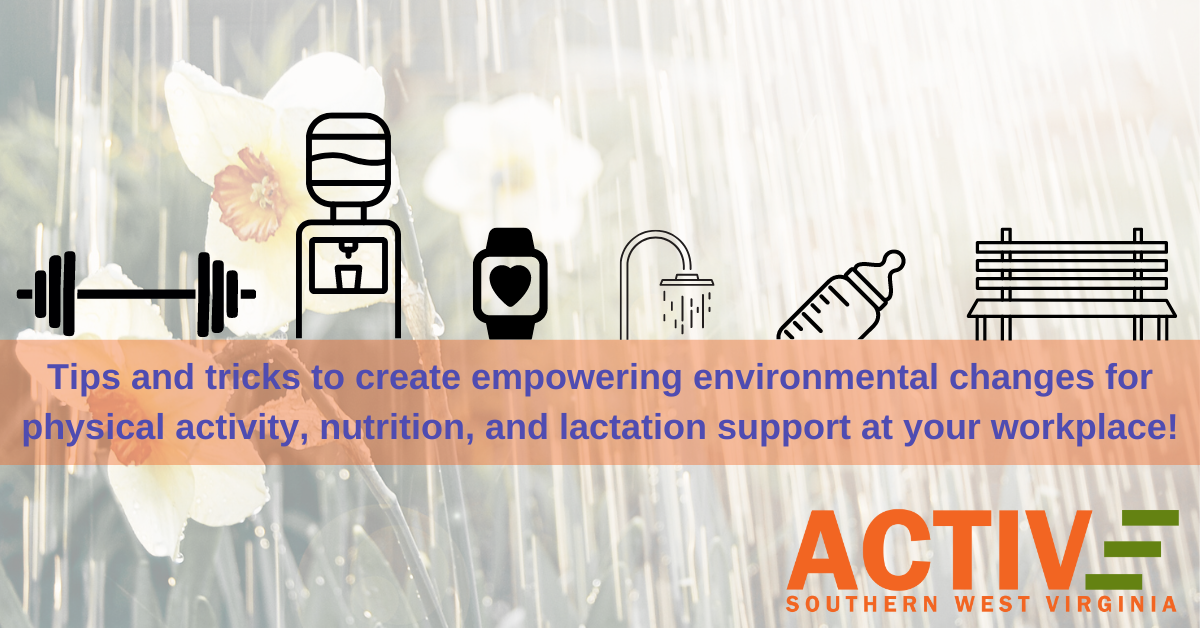
The seasons are changing and now’s the time to get back outside for some empowering Workplace Wellness programming! Follow along to learn how environmental changes in the workpalace can increase health, wellbeing, and general worker happiness!
What are workplace environmental changes?
We spend most of our work days clocked in, behind a screen, in the field, or on our feet. As such, it is important to think about the place we work as an extension of our personal health choices. If a workplace creates permanent environmental changes, to increase employer wellness, we consider this a Workplace Environment change. These types of changes can reach every individual at an organization, making the healthy choice the easy choice – for all!


How can these increase employee happiness and productivity?
- Physical inactivity may result from long work hours, cost of fitness facilities or equipment, and lack of flexibility in when and how long breaks can be taken.
- Poor diet may result from lack of access to healthy snacks or meals at work, lack of time to take breaks for meals, lack of refrigeration to store healthy foods, or lack of knowledge.
- Link to source.
Factors like limited access, resources, funding, and time can have major impacts on ones ability to make healthy choices at work. By increasing this access, we can give our employees the opportunity to be active, eat healthier, and stay more connected with one another throughout the work day. All in all, this type of focus can decrease absenteeism, increase employee satisfaction, increase productivity, and over all, show our staff they are valued and respected. The CDC Work@Health® course calls this last piece, the “Good place to work” argument. This becomes a major tool not only for employee retention, but also recruiting, as new employees will see Workplace Wellness resources as a reason for coming to a new job, or staying there for time.
Pick the low hanging fruit
We don’t have to reinvent the wheel to make environmental changes around the workplace. One of the most effective methods is to add more signage and education materials giving your staff information on the resources they already have available!
From here, taking the Work@Health® certification course is a great way to see what low hanging fruit may be at your workplace!
Common low hanging environmental fruit:
- Moving designated smoking areas 50 feet or more from building egress points.
- Creating a mapped walking path that displays total steps/distance for the workplace to use. Adding a bench to this path can expand access to those who may have difficulties with stamina or mobility.
- Adding or increasing access to water and sugar free hydration around the workplace.
- Creating or expanding physical activity space or safe lactation space for your staff.
- Provide healthy snacks like fresh fruit and salad bars during meetings and workplace events.
- Providing shower facilities for staff to use after being physically active at work.

What are others doing around West Virginia
Many organizations and workplaces across the Mountain State have created or expanded Workplace Wellness initiatives at their locations! You can find success stories and outcomes from organizations focusing on their workers here!
This month, we are happy to highlight the support that FamilyCare Health Centers has received from leadership to create new Workplace Wellness programs at 6 of their South East Charleston locations! To read more about Merinda Stricklen, PAC, MPH, Director of Community Education and her goal to increase the health of FamilyCare staff, click here!


